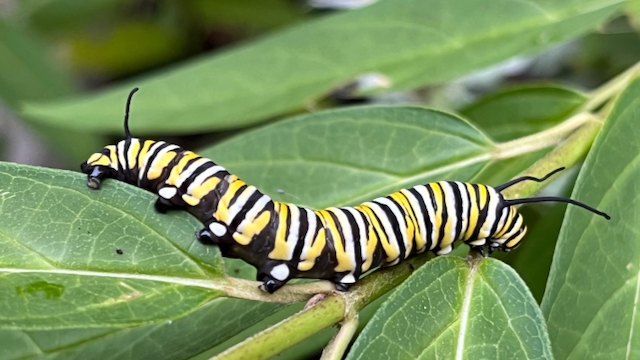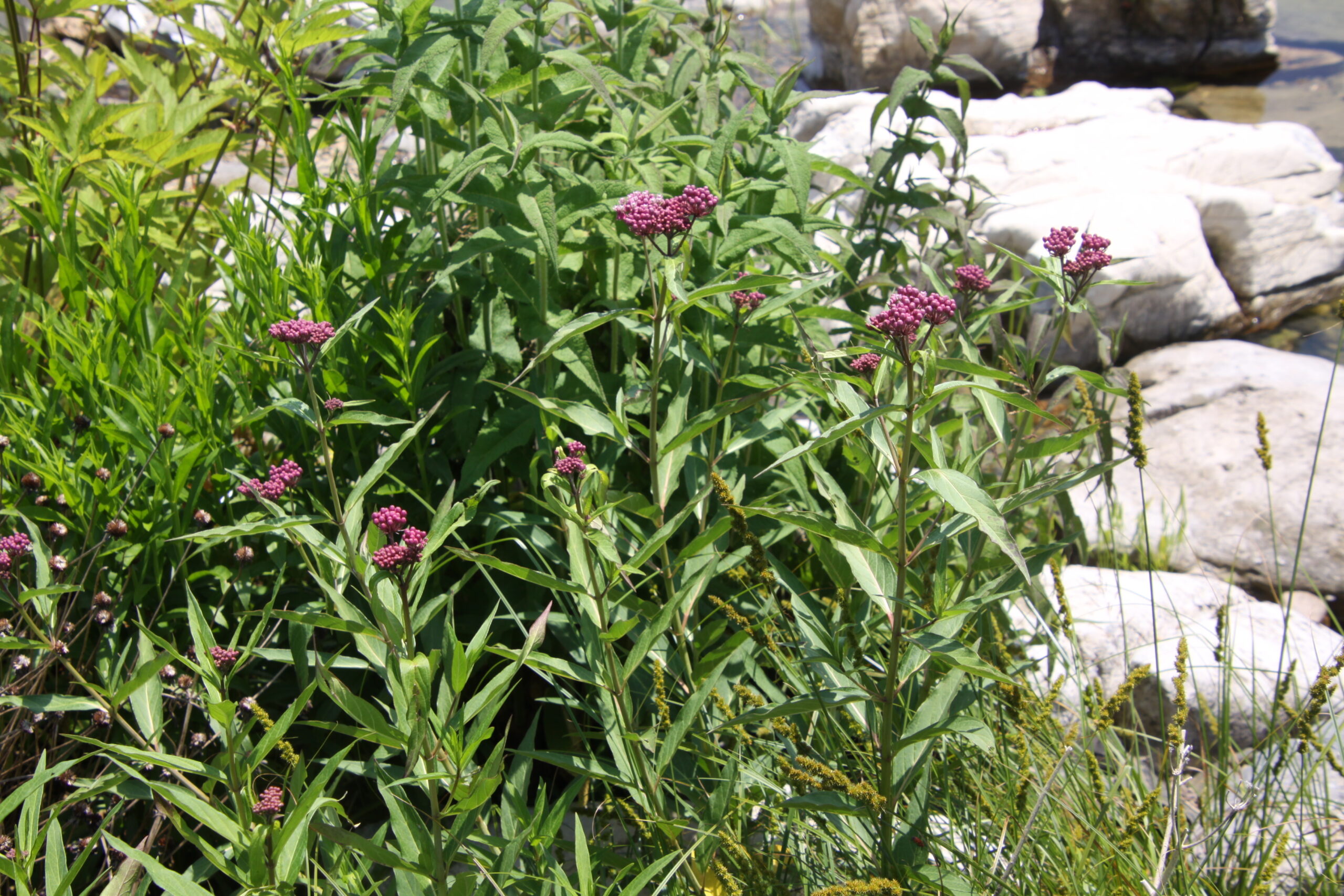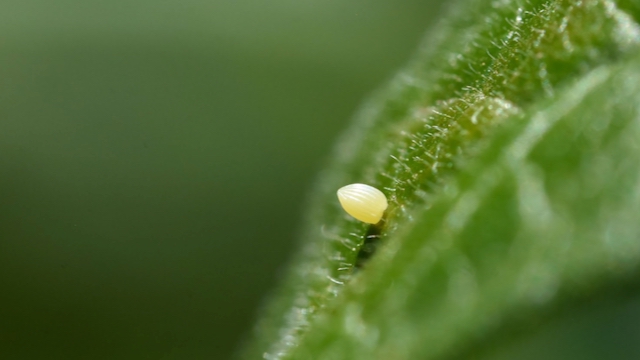Become a Monarch Champion
A State College Sunrise Rotary Pollinator Committee Initiative
Why Become A Monarch Champion?
Monarch caterpillars only eat milkweed. This is called a host plant. So, if there is no milkweed, there are no monarchs.
The bad news is that because of urbanization, there is less natural habitat and therefore less milkweed. The amount of milkweed available for monarch caterpillars to feed on has declined over time, and monarchs are now on the endangered species list.
The good news is that there’s something that we can do in our own backyards to help the monarchs: grow milkweed.

What Can We Do To Help?
Planting a local native species of milkweed is always best. We’ve provided you with a seed packet of Asclepias incarnata, commonly known as swamp milkweed, an ecotype particularly suited to Pennsylvania.
Growing milkweed is relatively easy, once it gets established. Of course the monarch caterpillars will love it, but many other insects also enjoy milkweed flowers and leaves.

Wait, You Want Me To Plant a WEED?
Sure, the milkweed might not be the most beautiful plant, but it isn’t a weed. The definition of a weed is a plant growing where it is not wanted. We want milkweed in our gardens!
Milkweed is a perennial plant native to our area, so it is not invasive. Even though milkweed might have “weed” in the name, it is a beneficial plant for many insects in our area.
Perennial plants regrow year after year, so you can enjoy this milkweed and the monarchs that use it for a long time with minimal effort.
Swamp milkweed is less aggressive and more manageable than other species of milkweed making it a great addition to your garden. The photo below was taken by Andy Stephenson in The Arboretum at Penn State.

How Should We Plant Milkweed From Seed?
When selecting a place in your garden to plant swamp milkweed seeds, choose an area that receives full sun. As the name implies, this plant thrives in moist soil.
Swamp milkweed (Asclepias incarnata) can grow up to five feet tall, so it is great to put in the back of a flower bed, or in a bed on its own. You’ll want to clear other vegetation such as grass from the area so that the soil is bare where you intend to plant.
Your seed packet includes enough seeds to plant twenty-five square feet. You can choose to plant the seeds in one area, or scatter them between other plants.
Timing is key! Don’t wait to plant your seeds until the spring – they actually need to experience cold weather in order to sprout. Plant your seeds as soon as you receive them.
As the ground freezes and thaws, the hard outer seed covering will break down. This is necessary for the seeds to germinate in the spring.
Place seeds on bare soil and simply tap them down. You may cover the seeds with a thin layer of soil or leaf litter, but seeds should remain near the surface of the garden bed.
Keep in mind that not every seed will grow, so we’ve included extra. Plant all the seeds in the packet for best results.
What’s Next?
Watch for milkweed to sprout! Please be aware that milkweed may come up later in the spring than other perennial plants in your garden.
The first monarch butterflies in Pennsylvania are usually spotted in the late spring. You can follow the monarch migration on the Journey North website. You can then start looking for monarch eggs. They are usually laid on the underside of a leaf near the top of a plant. Eggs are white or off-white and about the size of a pinhead.

Caterpillars are fun to look for because they are voracious eaters and easy to spot. First look for signs of the leaves being chewed on, also known as signs of herbivory. You can also look for frass, which is the term for insect droppings. Lastly, you can look for the caterpillars themselves on both sides of milkweed leaves, or on the stems.
Other insects will also enjoy your milkweed, such as aphids, spiders, and beetles. They are all part of the natural ecosystem and should not be removed. Monarch butterflies are well adapted to survive from predators. Two strategies they use for species survival are their toxicity to predators and that they lay many eggs with the hope that at least some will survive.

Report Back
Creating habitat for monarchs can be a joyful experience. It is fun to know that you are helping to conserve local biodiversity through the one simple action of planting milkweed.
We’d love to hear from you! Please share pictures and stories of your milkweed growing efforts so we can share in your monarch conservation adventures. We’d also like to understand the impact of our project so we can continue this work in the future.
We’re so excited to hear from you that we will be selecting three entries to receive a monarch garden sign. Submit your photos or stories by September 1, 2023.
Ideas for sharing:
• Planting seeds •
• The first milkweed sprouts in the spring •
• A selfie with your milkweed •
• A picture of your garden •
• Cute caterpillars •
• Monarch spotting •
You can share your photos and stories with us by filling out this simple submission form. You can also share on social media using the hashtag #MonarchChampion.
Remember to submit your photos or stories by September 1, 2023!
Get Connected
We just know that once you start growing milkweed and nurture your first crop of monarchs you will be hooked. There are so many ways to grow your involvement in monarch conservation! Here are a few resources to get you started:
Monarch Watch Certify your milkweed patch as an official Monarch Waystation, participate in community science projects, and get involved in tagging and recovery efforts.
Monarch Joint Venture Take your love of monarchs to the next level with this wealth of high quality information about monarch conservation including monarch educational opportunities, research projects and advocacy efforts.

Thank You!
We’ve had a blast planning this project, and we hope that you enjoyed it too.
We’d like to thank the 3 Dots Awesome Foundation for making this project possible.

How To Join Us
Does doing positive work in the community appeal to you? We’d love to have you check out our organization, State College Sunrise Rotary Club.
Address
P.O. Box 1133 State College, PA 16804
